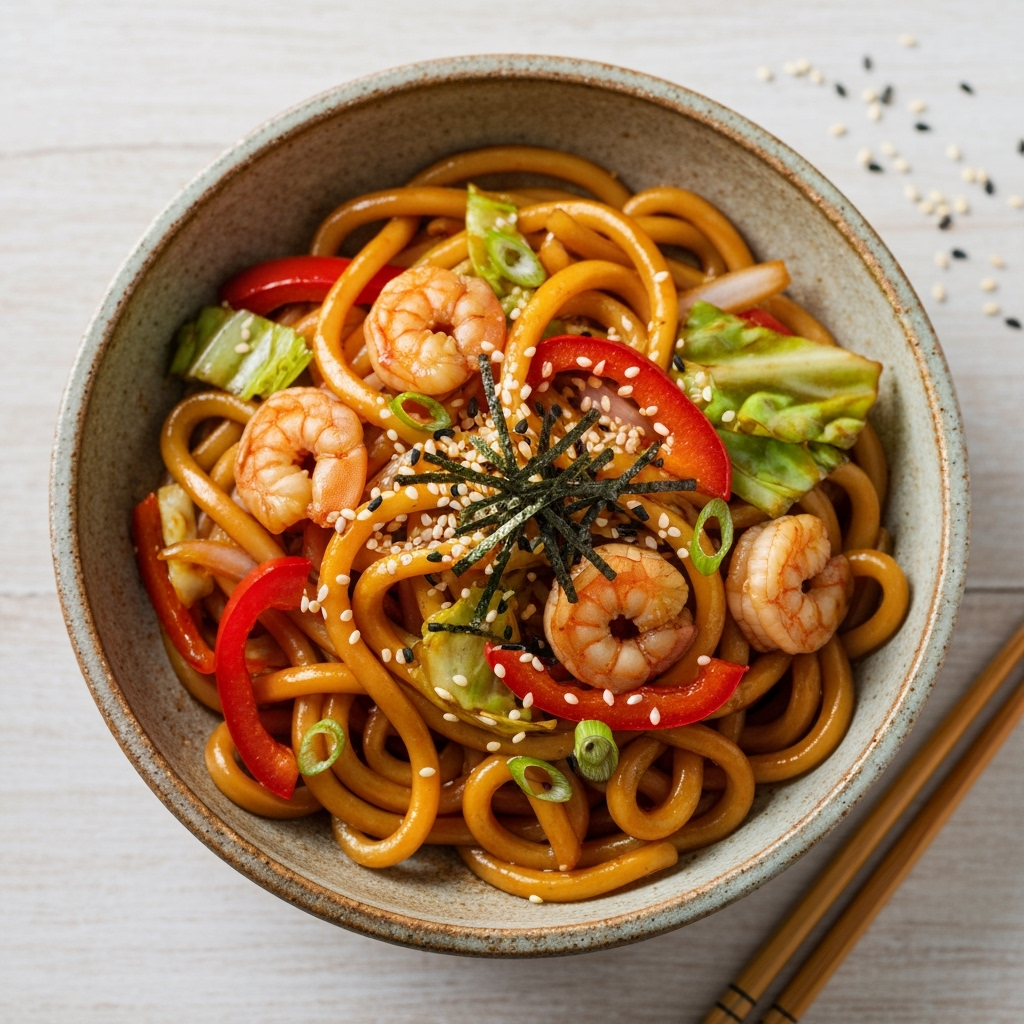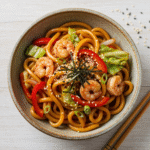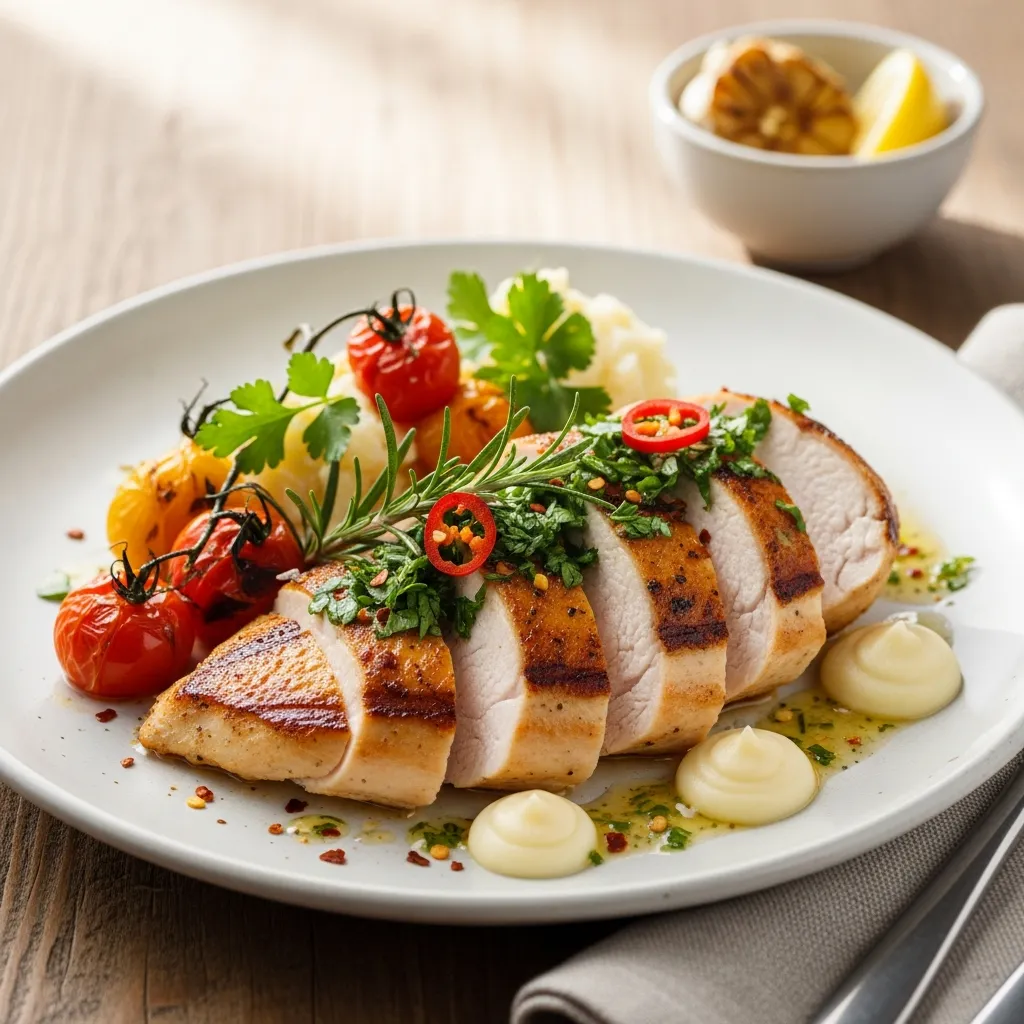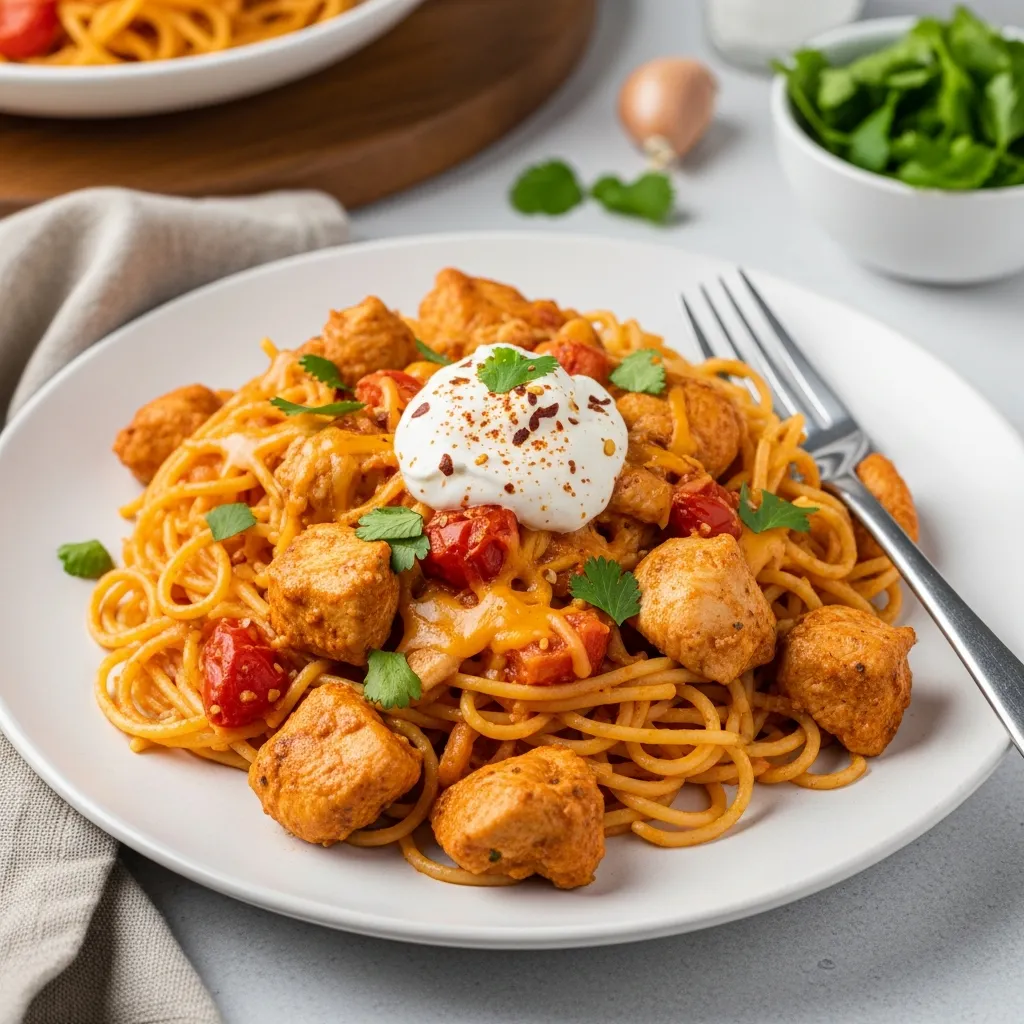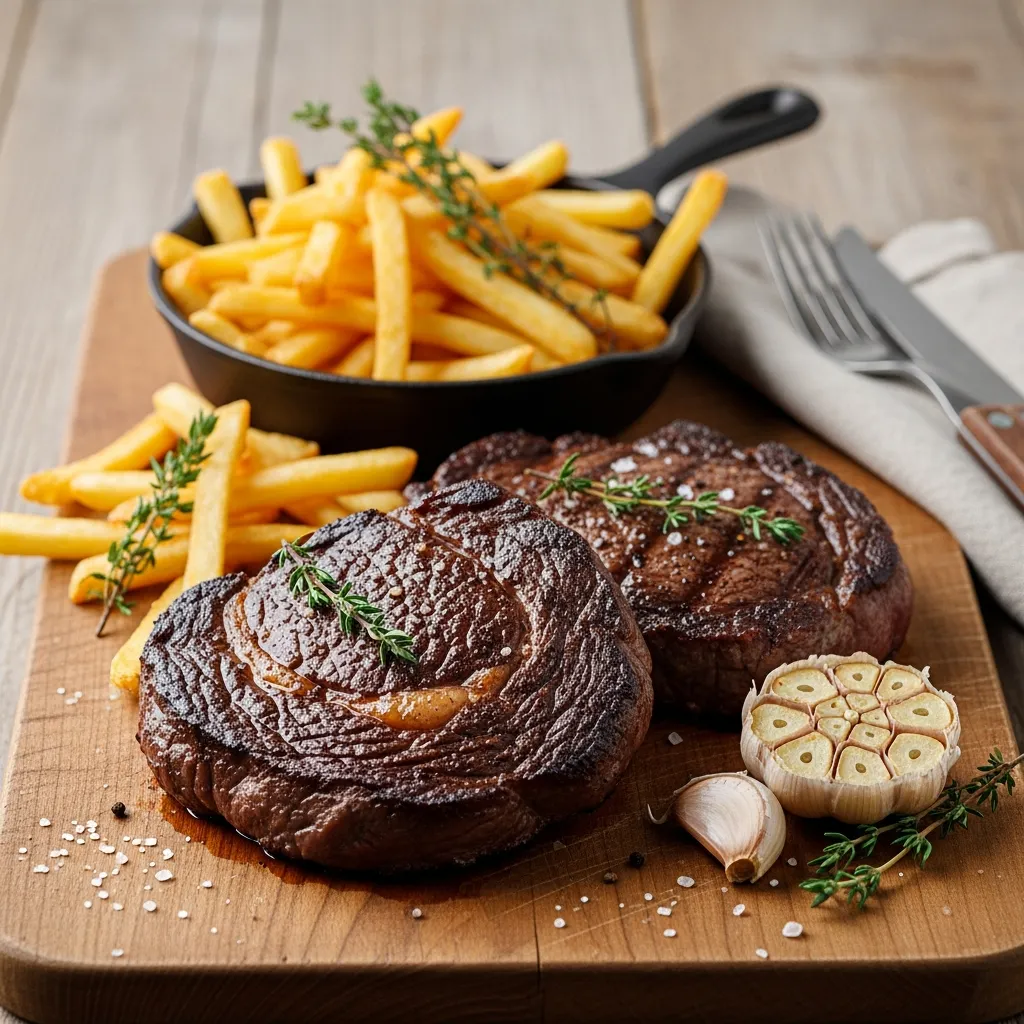There’s something magical about a meal that comes together faster than you can decide what to watch on TV. This irresistible Yaki Udon Noodle Recipe has become my family’s ultimate weeknight savior—a vibrant, savory stir-fry that feels like a treat but is deceptively simple to make. I first fell in love with yaki udon during a busy period when cooking felt like a chore, and this dish single-handedly brought the joy back into my kitchen. It’s the perfect harmony of chewy udon noodles, crisp vegetables, and a deeply flavorful sauce that clings to every strand. Whether you’re new to Japanese cooking or a seasoned pro, this version is forgiving, fast, and fantastically delicious.
Table of Contents
Irresistible Yaki Udon Noodle Recipe Ingredients
This irresistible Yaki Udon Noodle Recipe relies on a simple lineup of fresh and pantry-friendly ingredients. The beauty of this dish is its flexibility; you can easily swap vegetables based on what you have on hand.
- 2 packages (7 oz each) fresh or frozen udon noodles
- 2 tablespoons vegetable oil
- 2 cloves garlic, minced
- 1 tablespoon fresh ginger, grated
- 1 small onion, thinly sliced
- 1 large carrot, julienned
- 1 bell pepper (any color), thinly sliced
- 2 cups green cabbage, shredded
- 2 green onions, sliced (white and green parts separated)
- Protein of choice: 1 cup sliced chicken, beef, shrimp, or firm tofu
- For the Yaki Udon Sauce:
- 3 tablespoons soy sauce (or tamari for gluten-free)
- 1 tablespoon oyster sauce (or vegetarian oyster sauce)
- 1 tablespoon mirin
- 1 teaspoon sesame oil
- 1 teaspoon sugar
- Optional: 1/2 teaspoon chili garlic sauce or a pinch of red pepper flakes for heat
Smart Swaps: No fresh udon? Dried udon works perfectly; just cook according to package directions. For a vegetarian version, use the vegetarian oyster sauce and load up on mushrooms for a meaty texture. If you’re out of mirin, a splash of rice vinegar with a pinch of sugar is a great substitute.
Quick Yaki Udon Timing
- Prep time: 10 minutes
- Cook time: 10 minutes
- Total time: 20 minutes
That’s right—from fridge to table in just 20 minutes, making it about 30% faster than ordering takeout.
Step-by-Step Yaki Udon Instructions
Follow these simple steps for a perfect stir-fry every time. The key is having all your ingredients prepped and ready to go before you start cooking.
- Prepare the Noodles: If using fresh or frozen udon, loosen the noodles according to package instructions (usually a quick blanch in hot water or a brief microwave). If using dried udon, cook until al dente, drain, and rinse with cold water to stop the cooking process. Set aside.
- Make the Sauce: In a small bowl, whisk together all the sauce ingredients—soy sauce, oyster sauce, mirin, sesame oil, and sugar. This ensures no clumping and a perfectly blended flavor.
- Stir-Fry the Aromatics and Protein: Heat a large wok or skillet over high heat. Add the vegetable oil. Once hot, add the garlic and ginger, stir-frying for just 30 seconds until fragrant. Add your protein and cook until nearly done (chicken/beef should be cooked through, shrimp should be pink, tofu should be golden). Remove the protein from the wok and set aside.
- Cook the Vegetables: In the same wok, add a bit more oil if needed. Add the onion, carrot, and bell pepper. Stir-fry for 2-3 minutes until they begin to soften. Then, add the cabbage and the white parts of the green onions. Continue to stir-fry for another 2 minutes until the vegetables are tender-crisp.
- Combine Everything: Return the cooked protein to the wok. Add the prepared udon noodles and the reserved sauce. Using tongs or two spatulas, toss everything together vigorously for 1-2 minutes, ensuring the sauce coats every ingredient and the noodles are heated through.
- Finish and Serve: Turn off the heat. Stir in the green parts of the green onions. Give it one final toss and serve immediately.
Pro Tip: Do not overcrowd the wok. If your skillet is small, cook the vegetables in two batches to ensure they get a nice sear instead of steaming.
Yaki Udon Nutritional Information
(Per serving, serves 4, without additional protein)
- Calories: 320
- Carbohydrates: 55g
- Protein: 10g
- Fat: 8g
- Fiber: 5g
- Sodium: 980mg
This dish is a good source of Vitamin A from the carrots and Vitamin C from the bell peppers.
Equipment Needed for Yaki Udon
You don’t need any fancy tools for this recipe. A large wok or a 12-inch skillet is ideal for giving the ingredients plenty of room to stir-fry properly. You’ll also need a good chef’s knife for prepping the vegetables, a mixing bowl for the sauce, and a set of tongs for easy tossing.
Why You’ll Love This Irresistible Yaki Udon Noodle Recipe
- Incredibly Fast: A satisfying, restaurant-quality meal in just 20 minutes is a game-changer for busy weeknights.
- Endlessly Customizable: This recipe is a fantastic template. Swap in your favorite veggies, use whatever protein you have, or adjust the sauce to your taste. If you enjoy this flexibility, you might also love our Creamy Gochujang Udon Noodles for another flavor adventure.
- Family-Approved: The savory, umami-rich flavor is a hit with both kids and adults, making dinnertime disputes a thing of the past.
- Budget-Friendly: It’s a cost-effective way to enjoy a Japanese stir-fry at home, using affordable and accessible ingredients.
Healthier Alternatives for Yaki Udon
This recipe is already quite balanced, but you can easily tweak it to meet specific dietary needs.
- Gluten-Free: Use 100% buckwheat soba noodles or rice noodles, and ensure your soy sauce (tamari) and oyster sauce are certified gluten-free.
- Lower Sodium: Use low-sodium soy sauce and reduce or omit the oyster sauce, adding a touch more mirin and a pinch of mushroom powder for depth.
- Lower Carb: Swap the udon noodles for spiralized zucchini or shirataki noodles. Increase the amount of protein and non-starchy vegetables like broccoli and mushrooms to make it more filling.
- Vegan/Vegetarian: Use tofu or tempeh as your protein and substitute the oyster sauce with a vegetarian alternative. Our Creamy Peanut Udon in 10 Minutes is another great plant-based option.
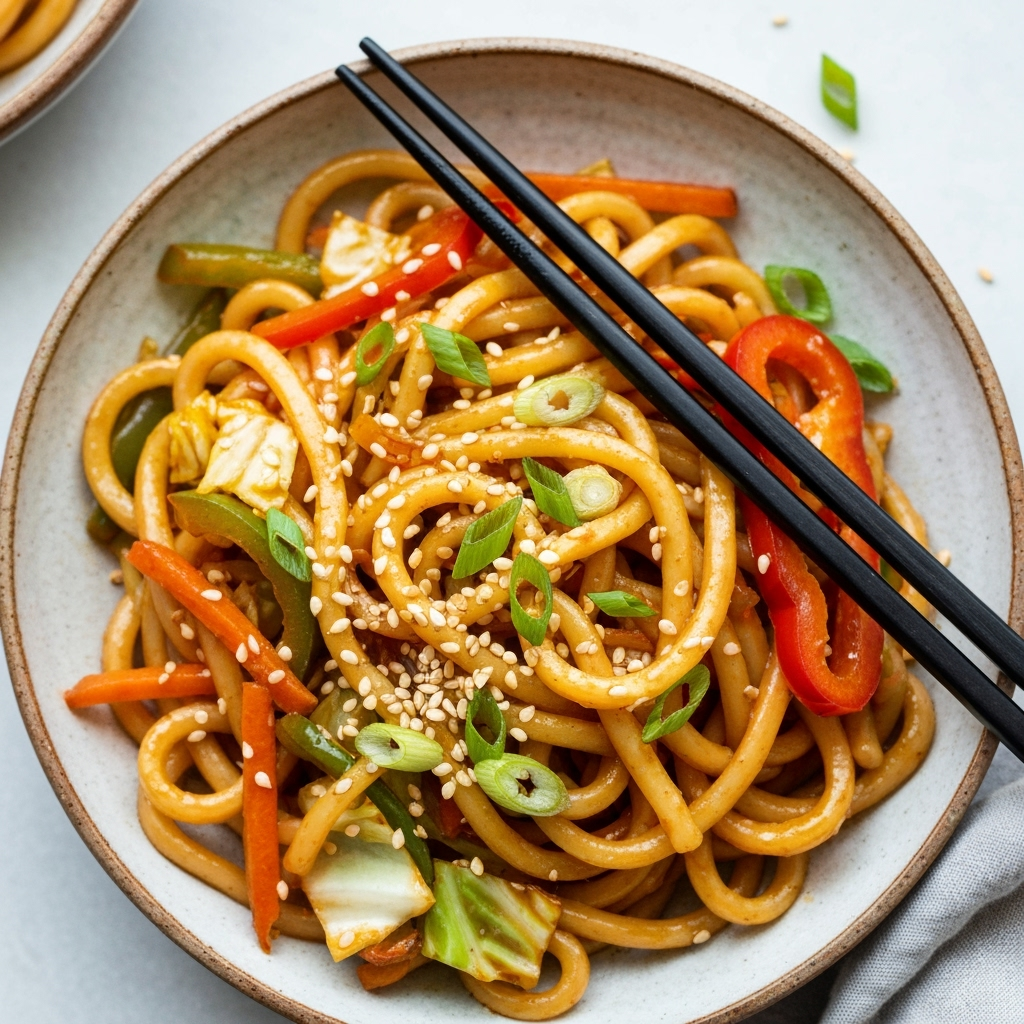
Yaki Udon Serving Suggestions
This dish is a complete meal on its own, but it pairs beautifully with a few simple sides. For a traditional Japanese meal experience, serve it with a small side of miso soup and a crisp cucumber salad. A soft-boiled egg or a sprinkle of bonito flakes (if you’re not vegetarian) adds a wonderful extra layer of flavor and protein. For a different but equally satisfying udon experience, try it alongside a bowl of our rich and comforting Curry Udon.
Common Mistakes to Avoid with Yaki Udon
- Using Overcooked Noodles: Udon noodles should be chewy, not mushy. Be careful not to overcook them during the initial prep, as they will cook a little more in the wok.
- Not Prepping Everything First: Stir-frying is a fast process. Have all your ingredients chopped, your sauce mixed, and your noodles ready before you turn on the heat. This is called mise en place, and it prevents burning.
- Crowding the Pan: Adding too many ingredients at once will steam them instead of giving them a nice, quick sear. Cook in batches if your pan isn’t large enough.
- Skipping the Tossing: The final step of tossing the noodles with the sauce over high heat is crucial. It allows the sauce to thicken slightly and cling to the noodles, creating the signature glossy finish.
Storing Tips for Yaki Udon
Leftovers can be stored in an airtight container in the refrigerator for up to 3 days. To reheat, sprinkle a tablespoon of water over the noodles and microwave in 30-second intervals, stirring in between, or reheat in a wok over medium heat. The noodles will soften a bit upon storage, but the flavor will still be excellent. I do not recommend freezing this dish, as the texture of the noodles and vegetables will become mushy upon thawing.
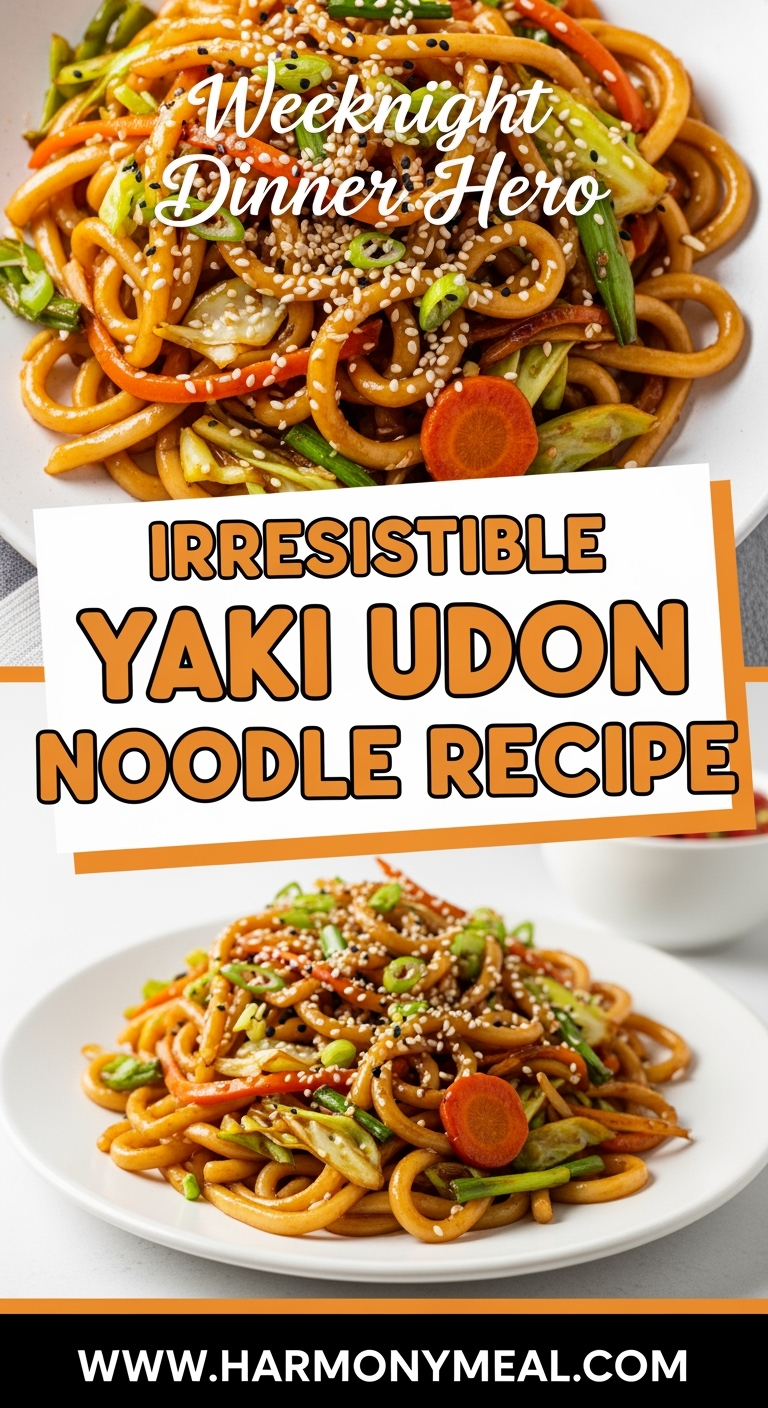
Final Thoughts on This Yaki Udon Recipe
This irresistible Yaki Udon Noodle Recipe is more than just a quick dinner; it’s a reliable path to a delicious and satisfying meal that never fails to impress. It’s the kind of dish that builds confidence in the kitchen and brings everyone to the table with happy anticipation. I hope it finds a regular spot in your meal rotation, just as it has in mine. If you’re looking for another quick and savory noodle fix, our Quick and Flavorful Beef Black Pepper Udon is a must-try.
I’d love to hear how your yaki udon turns out! What variations did you try? Share your creations and tips in the comments below, and don’t forget to tag @Harmonymeal on Pinterest to show off your beautiful bowls
FAQs about Irresistible Yaki Udon Noodle Recipe
What are the key ingredients for an irresistible Yaki Udon?
An irresistible Yaki Udon typically features chewy udon noodles, a savory stir-fry sauce (soy sauce, mirin, sake, oyster sauce or vegetarian alternative), thinly sliced meat (pork belly, chicken, or shrimp), and a medley of vegetables like cabbage, carrots, onions, and mushrooms, often garnished with katsuobushi (bonito flakes) and pickled ginger.
How do I prevent udon noodles from sticking together when stir-frying?
To prevent sticking, briefly blanch fresh or frozen udon noodles in boiling water for 1-2 minutes, then rinse immediately with cold water and drain thoroughly. This separates the noodles and removes excess starch, ensuring they stir-fry individually without clumping.
What’s the best type of udon noodle to use for Yaki Udon?
Fresh or frozen pre-cooked udon noodles are ideal for Yaki Udon as they have the perfect chewy texture and require minimal cooking. Avoid dried udon if possible, as they can sometimes become too soft or break apart easily during stir-frying.
Can I make Yaki Udon vegetarian or vegan?
Absolutely! For a vegetarian version, substitute meat with firm tofu, tempeh, or mushrooms, and replace oyster sauce with a vegetarian stir-fry sauce or a combination of soy sauce and mushroom broth. Ensure mirin and sake are vegan-friendly, and omit katsuobushi.
What’s the secret to a flavorful Yaki Udon sauce?
The secret lies in balancing umami, sweetness, and savoriness. A classic Yaki Udon sauce often combines soy sauce, mirin (sweet rice wine), sake (cooking wine), and a touch of sugar. Adding a dash of dashi broth or a vegetarian equivalent can further deepen the flavor profile.
Can Yaki Udon be prepared ahead of time or made for meal prep?
While Yaki Udon is best enjoyed fresh off the wok, you can prepare components like chopping vegetables and mixing the sauce ahead of time. Cooked Yaki Udon can be refrigerated for 1-2 days, but the noodles might become a bit softer upon reheating.
Irresistible Yaki Udon Noodle Recipe
There’s something magical about a meal that comes together faster than you can decide what to watch on TV. This irresistible Yaki Udon Noodle Recipe has become my family’s ultimate weeknight savior—a vibrant, savory stir-fry that feels like a treat but is deceptively simple to make.
- Prep Time: 10 minutes
- Cook Time: 10 minutes
- Total Time: 20 minutes
- Yield: 4 servings 1x
- Category: Main Course
- Method: Stir-fry
- Cuisine: Japanese
Ingredients
- 2 packages (7 oz each) fresh or frozen udon noodles
- 2 tablespoons vegetable oil
- 2 cloves garlic, minced
- 1 tablespoon fresh ginger, grated
- 1 small onion, thinly sliced
- 1 large carrot, julienned
- 1 bell pepper (any color), thinly sliced
- 2 cups green cabbage, shredded
- 2 green onions, sliced (white and green parts separated)
- Protein of choice: 1 cup sliced chicken, beef, shrimp, or firm tofu
- For the Yaki Udon Sauce:
- 3 tablespoons soy sauce (or tamari for gluten-free)
- 1 tablespoon oyster sauce (or vegetarian oyster sauce)
- 1 tablespoon mirin
- 1 teaspoon sesame oil
- 1 teaspoon sugar
- Optional: 1/2 teaspoon chili garlic sauce or a pinch of red pepper flakes for heat
Instructions
- Prepare the Noodles: If using fresh or frozen udon, loosen the noodles according to package instructions (usually a quick blanch in hot water or a brief microwave). If using dried udon, cook until al dente, drain, and rinse with cold water to stop the cooking process. Set aside.
- Make the Sauce: In a small bowl, whisk together all the sauce ingredients—soy sauce, oyster sauce, mirin, sesame oil, and sugar. This ensures no clumping and a perfectly blended flavor.
- Stir-Fry the Aromatics and Protein: Heat a large wok or skillet over high heat. Add the vegetable oil. Once hot, add the garlic and ginger, stir-frying for just 30 seconds until fragrant. Add your protein and cook until nearly done (chicken/beef should be cooked through, shrimp should be pink, tofu should be golden). Remove the protein from the wok and set aside.
- Cook the Vegetables: In the same wok, add a bit more oil if needed. Add the onion, carrot, and bell pepper. Stir-fry for 2-3 minutes until they begin to soften. Then, add the cabbage and the white parts of the green onions. Continue to stir-fry for another 2 minutes until the vegetables are tender-crisp.
- Combine Everything: Return the cooked protein to the wok. Add the prepared udon noodles and the reserved sauce. Using tongs or two spatulas, toss everything together vigorously for 1-2 minutes, ensuring the sauce coats every ingredient and the noodles are heated through.
- Finish and Serve: Turn off the heat. Stir in the green parts of the green onions. Give it one final toss and serve immediately.
Notes
Pro Tip: Do not overcrowd the wok. If your skillet is small, cook the vegetables in two batches to ensure they get a nice sear instead of steaming. Smart Swaps: No fresh udon? Dried udon works perfectly; just cook according to package directions. For a vegetarian version, use the vegetarian oyster sauce and load up on mushrooms for a meaty texture. If you’re out of mirin, a splash of rice vinegar with a pinch of sugar is a great substitute.
Nutrition
- Serving Size: 1 serving
- Calories: 320
- Sugar: 8g
- Sodium: 980mg
- Fat: 8g
- Saturated Fat: 1g
- Unsaturated Fat: 6g
- Trans Fat: 0g
- Carbohydrates: 55g
- Fiber: 5g
- Protein: 10g
- Cholesterol: 0mg
💬 Let’s Stay Connected!
For daily recipes, kitchen tips, and exclusive content, follow me on:
👉 Facebook for behind-the-scenes & community fun
👉 Pinterest for visual inspiration & meal ideas
👉 X (Twitter) for quick tips & trending recipes
📲 Join the flavor journey, your next favorite recipe is just a follow away!

